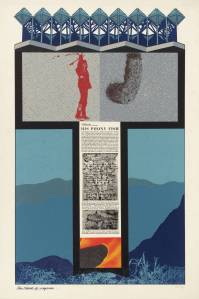As an art student in the 60s my interest in Kitaj’s prints developed alongside my enthusiasm for those of Eduardo Paolozzi. There are many fascinating similarities, visually, conceptually and technically. The catalyst for his uptake of the screenprint medium was Paolozzi’s introduction of Kitaj to Chris Prater at Kelpra Studio in 1962. As detailed in my coverage of Paolozzi’s work in http://paolozzi.blogspot.co.uk/ Prater facilitated and enhanced printmakers’ creativity not just through his supremely good technical ability but also because he built artistic rapport and empathy with them.
That year Paolozzi and Kitaj made a collaborative mixed media collage called Work in Progressive. Within two years Prater was producing stylistically similar screenprints for Kitaj, rich with multiple visual and literary references. 15 of these constitute the Mahler series.
Where Paolozzi formed a personal and creative empathy with Ludwig Wittgenstein, Kitaj did so with Gustav Mahler. Paolozzi’s empathy with the philosopher involved quite a lot of mutual angst, and so with Kitaj/Mahler:
He had felt a kinship with Mahler since he studied in 1950s Vienna, seeing hatred in the eyes of his landlady, his tutors, the shopkeepers. ‘The streets I walked on I could have been hauled off just a few years before,’ he said. Kitaj equated anti-Semitism with anti-modernism. ‘Jewish brilliance’, he said, ‘made the modern world.’ Jews like Mahler and Kitaj were agents of change, architects of human unease. (Norman Lebrecht, author and authority on Mahler).
Mahler Becomes Politics, Beisbol was created over the period 1964-67 and published in 1967 by Marlborough Fine Art Ltd. The fifteen prints and Title Page were presented in a yellow case mostly in an edition of 70, although there were 75 of some. Additionally a book of poems by Jonathan Williams was included with the first 30 of the edition. Typical size was 840 x 570 mm.
The print below is The Flood of Laymen. I especially like its 3D ‘architectural’ structure and the sharp contrast between the creation in the image of extensive space with the ‘flatness’ of the Phony Fish illustrations and text:


